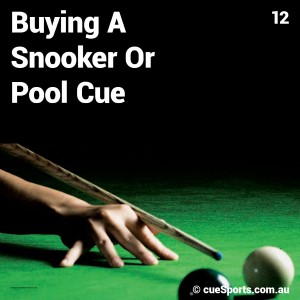Buying a Snooker / Pool Cue
So you are considering buying a new cue Well you'll be pleased to know that we've put together this article to answer some common questions and to help you decide on which cue suits you...
Q1) What is a splice and how does it effect the quality of the cue
The splices of the cue are the points you see where the ebony/rosewood part of the butt goes into the shaft. In terms of playing quality, the splices do not affect the cue, although, I would say that in machine spliced cues (where the splices are sharp pointed), the overall quality of the cue is compromised by a reduced quality shaft....basically manufacturers save their best shafts for the more expensive hand spliced cues. In terms of overall quality, then you would say that extra splices mean extra quality because the extra work and extra wood that is required to make a multi-spliced cue means that it will cost you more money!
Q2) Does playing with a snooker cue or a small tip cue mean it would be a bad thing to hit balls hard, such as when a lot of power is needed - high draw shots, breaks, etc. Would I have to get a seperate break cue Snooker players don't really hit balls hard and the table's natural, yet fast, speed, take care of that.
Most players have between an 8 and 10mm tip. Some break with their playing cue but it is becoming more and more common to have a seperate break cue. Obviously, repetitive stress (e.g. break off shot) on any material causes a degree of wear so you are wearing your playing cue tip by breaking off with it. However, if you achieve a good split of the balls with your playing cue then you should probably stick with it.
Q3) I have learnt that a small tip means one can generate more spin from the cue ball but is harder to register the middle of the cue ball. However, does a small tip also mean the tip is a lot more delicate and shots such as masse and swerve will potentially damage the cue Apart from chalking, what would one have to do to maintain an 8mm tip
A well fitted 8mm tip should allow you to play all types of shot. Adding to my response to question 2, due to the nature of a masse shot (i.e. when you are striking down on the cueball), you are placing stress on the tip. Since the action required to generate the neccessary spin onto the cueball involves the cueball sliding towards the edge of the tip during contact, you will inevitably, wear the tip down quicker if you are playing a lot of masses shots. So, my advice is to play masse shots only when they are required (not just when you want to show off in the pub!) and to regular shape and burnish your tip. Also, tips with a harder consistency such as triangle tips will last longer so you could experiment with your tip choice until you find a type that suits you best.
Q4) If the tip is bigger, does this mean a tip which can give less spin Or is it all in the dome shape of the tip
Much depends on how well you strike the cue ball and time your stroke. I know top pool players who achieve more spin with a 10mm tip than most do with an 8 mm tip. However, what I would say is that you may find it easier to generate spin with a smaller tip but I haven't seen you play. Adding to my response to question 3 - with a smaller tip, you may apply unintentional side to the cueball, especially when you are under pressure because your action may not be as smooth. Again, a lot depends on personal preference but a tip between 8 and 9mm should be about right for you.
| Object Ball Size | 1 7/8" Balls | 2" Balls | 2 1/16" Balls | 2 1/4" Balls |
| Cue Ball Size | 1 7/8" | 1 7/8" English | 2 1/16" English | 2 1/4" American |
| Table Size | 6 x 3 | 7 x 3.6 or 8 x 4 | 12 x 6 | 9 x 4.6 |
| Game | Kids Pool | English 8 Ball | English Snooker | American 9 Ball |
| Cue Length | 48" to 54" | 57" is standard | 58" is standard | 58" is standard |
| Tip Size | 11mm | 9mm 9.5mm 10mm | 9.5mm 10mm 11mm | 13mm 14mm |
| Weight | 16 to 17oz | 17 to 18 oz | 18oz to 19oz | 21oz |
| Beginner | 11mm | 10mm | 11mm | 13mm |
| Pro | If you like spin 9mm | 10mm | 13mm | |
| Shaft | Ramin | American White Ash | English Ash | Canadian Maple |
Note: The Average Australian Pub Pool Cue is a 57" Ramin Cue with an 11mm Screw-on tip
Q5) I am just over 6ft (tall for a 20 yr old!), so what cue length would suit me
Standard cue length is 57-58 ". There are players as tall as you who use cues shorter than this but I think it would be wise to go for a standard length cue.
Q6) How do I know if a cue does not suit me or it is just because it is new and I need to "wear it in with practice" This is important if I buy a cue off the internet, where choice is much more of a luxury but also where it'd be impractical to buy a cue, return it, buy another one, and so forth.
You'll need at least 4-6 weeks of practice to know whether a cue is right for you. During this time you'll experience highs and lows (hopefully more highs!)....what you must try to do during low points is to believe in and to know your own ability. Your thoughts when buying a cue should be to buy something that fits to your own game and playing ability. A new cue can improve your game but you must also apply yourself in the right way....don't expect miracles immediately but persevere and you'll find that you'll start to like a new cue once you've really got to know it plays.
Q7) What is the difference between a maple and ash shaft Does one or the other give a better performance
In appearance terms, a maple shaft is clear whilst an ash shaft has grain (you probably know this already)...my opinion is that most (but not all - and some will disagree) maple cues have a stiffer feel than ash shafts. My own cue certainly does but it is quite an old piece of wood. However, what you will find is that some maple cues are very whippy. Regardless of whether it's maple or ash, every piece of wood has it's own characteristics - my advice would be to stick to ash unless you try and like the feel of a particular maple cue.
Q8) Is there a difference in aluminum and plastic cases (the cheaper/cheapest ones) I have heard about humidity and certain case factors affecting the cue. Can anyone shed some light on this Does the rubbing the tip does on the case interior damage the tip When I leave my cue in its case and in the car, which is driven every day, and play, I see a lot of chalk marks in the case.
A good quality aluminum case is well padded on the interior. This padding is enough to protect your case during travel. There aren't many examples of plastic cases these days, with the exception of the long tube cases perhaps. With regards to the humidity factor, I'm really not sure which would be better but the plastic cases I know of don't have padding and so I think that an aluminum case will be your best option.
Product:
snooker pool cues buy
snooker pool cues shop
snooker and pool cues cheap
buy pool snooker cues
snooker cues for sale in Australia
snooker cues Australia
snooker pool cues for sale
snooker pool cues sale
snooker pool cues size
snooker pool cues tips
snooker supplies Australia

